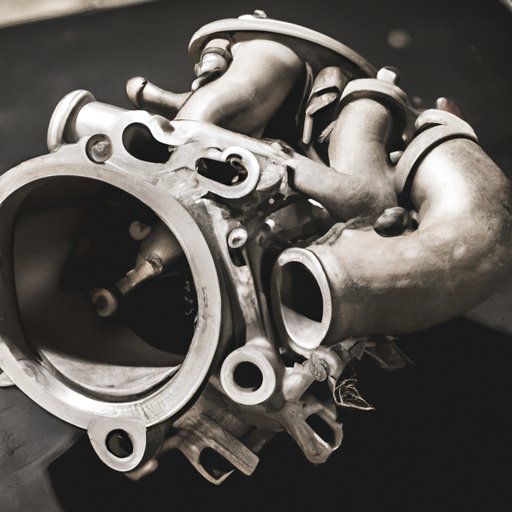Introduction
Turbocharging is a technology used in internal combustion engines to improve their performance and efficiency. It involves using a turbine to compress air into the engine, which allows more fuel to be burned and increases power output. This article will explore how turbo works, outlining the principle of turbocharging and its components, as well as the benefits and different types of turbochargers.

Explaining the Principle of Turbocharging
The principle behind turbocharging is fairly simple. A turbine is installed in the exhaust system of the engine, which spins when exhaust gases are expelled. This spinning action is then used to drive a compressor, which forces air into the engine. By forcing more air into the engine, it can burn more fuel and produce more power.
One of the main advantages of turbocharging is that it does not require any additional fuel to operate. The exhaust gases coming out of the engine provide the energy needed to spin the turbine, so no additional fuel is required. This helps to improve the fuel efficiency of the engine, as well as increasing its power output.

Outlining the Components of a Turbocharger
There are several components that make up a turbocharger, each with its own purpose. The first component is the exhaust manifold, which is where the exhaust gases from the engine enter the turbocharger. The exhaust gases then travel through the turbine, which uses them to spin its blades. This spinning action then drives the compressor, which takes in air from outside the engine and compresses it before forcing it into the engine.
The last component of a turbocharger is the wastegate. This is a valve that controls the amount of exhaust gas that enters the turbine, allowing the engine to maintain a consistent power output. Without the wastegate, the turbocharger would continue to increase in speed until it eventually fails.
Describing the Benefits of Turbocharged Engines
One of the main benefits of turbocharging is increased fuel efficiency. By forcing more air into the engine, it is able to burn more fuel and therefore produce more power. This means that the engine can do more work while using less fuel, resulting in improved fuel economy.
Another benefit of turbocharging is improved power output. By compressing the air entering the engine, it is able to create more power than a naturally aspirated engine. This makes turbocharged engines ideal for high-performance applications, such as racing or off-road driving.
Finally, turbocharged engines produce fewer emissions than naturally aspirated engines. Because they are able to burn more fuel, they produce fewer pollutants, helping to reduce their environmental impact.

Examining the Different Types of Turbochargers
There are several different types of turbochargers available, each with its own pros and cons. Single-turbochargers are the most common type, and are usually found on smaller engines. They are relatively simple and inexpensive, but can only generate a limited amount of power.
Twin-turbochargers are another option, and are typically used on larger engines. They offer more power than single-turbochargers, but are more expensive and complex. Finally, variable geometry turbochargers (VGTs) are the most advanced type of turbocharger, and are capable of producing a wide range of power outputs.
Comparing Turbochargers to Superchargers
Turbochargers and superchargers both serve the same purpose – to increase the power output of an engine. The main difference between the two is how they achieve this goal. Turbochargers use exhaust gases to spin a turbine, which then compresses air and forces it into the engine. Superchargers, on the other hand, use a belt or chain to drive a compressor, which does the same job.
Both types of forced induction systems have their own advantages and disadvantages. Turbochargers are generally more efficient than superchargers, as they don’t require any additional fuel to operate. Superchargers, however, are able to provide instant power, whereas turbochargers take a few seconds to spool up.
Conclusion
In conclusion, turbocharging is a technology used to improve the performance and efficiency of internal combustion engines. It works by using a turbine to compress air and force it into the engine, allowing it to burn more fuel and produce more power. There are several components that make up a turbocharger, such as the exhaust manifold, turbine, compressor and wastegate. Turbocharging has many benefits, including increased fuel efficiency, improved power output and reduced emissions. There are also several types of turbochargers available, such as single-turbochargers, twin-turbochargers and variable geometry turbochargers. Finally, turbochargers and superchargers are similar in that they both increase power output, but differ in how they achieve this goal.
Overall, turbocharging is a reliable and effective way to get more power out of an engine without sacrificing fuel efficiency. It is an important technology for modern engines, and one that will continue to be developed and improved upon in the future.
(Note: Is this article not meeting your expectations? Do you have knowledge or insights to share? Unlock new opportunities and expand your reach by joining our authors team. Click Registration to join us and share your expertise with our readers.)
